Clinical effect of enriching qi, activating blood circulation, clearing away dampness and heat combined with western medicine in the treatment of idiopathic membranous nephropathy: A meta-analysis
Zheng-Mei Zhang, Zi-Long Shen, Mei-Jie Wang, Jing Li✉
1. Dongzhimen Hospital, Beijing University of Chinese Medicine, Beijing 100700, China
2. Department of Nephrology, Beijing Hospital of Traditional Chinese Medicine, Capital Medical University, Beijing 100010, China
Keywords:Idiopathic membranous nephropathy Meta-analysis Enriching qi Activating blood circulation Clearing away dampness and heat
ABSTRACT Objective: To systemically review the efficacy and safety about the method of enriching qi, activating blood circulation, clearing away dampness and heat combined with western medicine in the therapy of patients with idiopathy membranous nephropathy (IMN).Methods: We collected the randomized controlled trials (RCTs) of enriching qi, activating blood circulation, clearing away dampness and heat for the treatment of IMN from Pub Med,The Cochrane Library, Medline, China National Knowledge Infrastructure (CNKI), China Biology Medicine disc (CBM), Wanfang Data and Wiper Databases. Bias of risk of retrieval literature was evaluated according to Cochrane Collaboration standard, and Review Manager 5.3 software was used for statistical analysis. Results: Fourteen trials (836 participants) were included in the meta-analysis. This kind of traditional Chinese method combined with western medicine in the treatment of IMN exerted statistical differences in reducing 24-hour urinary protein [WMD=-0.97, 95%CI(-1.30,-0.65), Z=5.86(P<0.00001)] and elevating serum albumin[WMD=3.83, 95%CI(2.10, 5.57), Z=4.33, P<0.0001], lowering serum cholesterol [WMD=-0.82, 95%CI(-1.08, -0.56), Z=6.18, P<0.00001], triglycerides [WMD=-0.39, 95%CI(-0.67,-0.11), Z=2.77, P=0.006] and reducing the risk of adverse events[OR=0.29, 95%CI[0.16, 0.50],Z=4.35, P<0.0001] in the patients with IMN as compared with controls. However, there was no statistically significant difference between the method and controls when combining all trials in serum creatinine [WMD=-5.52, 95%CI(-18.06, 7.03), Z=0.86, P=0.39], when combining all trials in urea nitrogen[WMD=-0.90, 95%CI(-2.22, 0.41), Z=1.35, P=0.18]. Conclusion:The method of enriching qi, activating blood circulation, clearing away dampness and heat combined with western medicine exerts certain advantages and better safety in treating patients with IMN. However, for the inferiority of the included studies, the conclusion still needs highquality and large-sample prospective randomized controlled trials to verify.
1. Introduction
Idiopathic membranous nephropathy, a primary glomerular disease [1], is one of the common pathological types of nephrotic syndrome in adults [2] and its etiology is unknown. In our country,the incidence of IMN has increased from 10.4% in 2003 ~ 2006 to 24.1% in 2011 ~ 2014, showing an increasing trend year by year and a preference for the middle-aged and old aged [3]. About 50% of IMN patients have typical manifestations of nephrotic syndrome and about 30% of adult patients progress to end-stage renal disease after 10 years [2]. According to the clinical practice guidelines for glomerulonephritis issued by the improving global outcomes in renal disease organization in 2012, we recommend the use of basic treatment such as blood pressure lowering and anticoagulation for IMN patients, and glucocorticoids combined with cyclophosphamide or calcineurin inhibitors for those who meet the indications for immunosuppressive therapy [4]. However,clinical studies have shown that immunosuppressive therapy does have efficacy, but there are problems such as high relapse rate and increased risk of hospitalization after discontinuation, and it causes some financial burden on patients [5]. The treatment of IMN by traditional Chinese medicine (TCM) has some advantages in alleviating urinary protein and reducing recurrence rate of patients,and there are many studies using the combination of the method of enriching qi, activating blood circulation, clearing away dampness and heat and Western medicine to treat IMN in clinic, but the efficacy is variable. In this study, a Cochrane systematic review was conducted to objectively evaluate the efficacy and safety of this method and Western medicine to treat IMN. In the hope of providing evidence-based evidence for clinical application.
2.Methods
2.1 Data sources
The following databases were searched: VIP database, Wanfang database, China knowledge net, Chinese biomedical literature database, the Cochrane Library, Pub Med, MEDLINE. Years retrieved: building the library until October 2021. Chinese database search terms: idiopathic membranous nephropathy, membranous nephropathy, Qi deficiency, blood stasis, dampness, heat, Yiqi,invigorating Qi, invigorating blood, removing stasis, diuresis,dampness, clearing heat, etc. Among them, idiopathic membranous nephropathy, membranous nephropathy were searched by subject heading search, Qi Deficiency, blood stasis, dampness, heat, Yiqi,Invigorating Qi, invigorating blood, removing stasis, diuresis,dampness, clearing heat were searched in full text articles. English database search terms included: IMN, Idiopathic Membranous Nephropathy, Membranous Nephropathy, MN, clinical trials,Traditional Chinese Medicine, randomized controlled trials.
2.2 Eligibility criteria
Type of literature: randomized controlled trial of Yiqi Huoxue Qingli method combined with western medicine in the treatment of IMN (randomized controlled trials, RCTs), whether blind or covert grouping is used. Subjects: patients over 18 years old who are determined as Mn by renal biopsy pathology or serum anti phospholipase A2 receptor antibody; the baseline levels of subjects in the experimental group and the control group are comparable.Intervention measures: the control group is treated with western medicine, and the treatment group uses traditional Chinese medicine on the basis of the control group. The treatment group was treated with blood dampness and heat clearing method, or the treatment group was treated with traditional Chinese medicine of Enriching Qi,activating blood circulation, dampness and heat clearing on the basis of the control group, with unlimited dosage form, dose and course of treatment. Efficacy indicators: the main efficacy indicators were 24-hour urinary total protein quantity (24hUTP), serum albumin (ALB),and the secondary efficacy indicators were total cholesterol (TC),triglyceride (TG), serum creatinine (Scr) and urea nitrogen (blood urea nitrogen, BUN). The safety index is the occurrence of adverse reactions.
2.3 Exclusion criteria
Neither Chinese or English literature, observational studies,reviews, systematic reviews, non RCT studies, conference papers,duplicate published literature were excluded. The disease were caused by secondary factors such as autoimmune diseases, tumors,viral hepatitis, drugs and heavy metals. The intervention measures in the treatment group were not the method of enriching qi, activating blood circulation, clearing away dampness and heat or the study with unknown main composition.
2.4 Literature screening and data extraction
Two researchers conducted independent evaluation and extracted clinical data.By browsing the title, reading the abstract, making a preliminary judgment, reading the full text of the literature that meets the inclusion conditions, and screening those who meet the inclusion criteria.In case of disagreement, the third person participates in the discussion and settlement.Data extraction included: literature title,author, source and year of publication; Methods of random grouping,sample size, intervention measures, course of treatment, TCM treatment methods and prescriptions, outcome indicators and adverse reactions.
2.5 Bias risk assessment
The bias risk of the included studies was assessed according to the Cochrane evaluation manual, including the generation of random sequence, covert grouping, the implementation of blind method in the study, the integrity of result data, selective outcome report and other offset sources.Two researchers independently evaluated the literature, in which "low risk" indicates low-risk bias, "high risk" indicates high-risk bias, and "unclear risk" indicates that the literature does not provide sufficient information for bias evaluation.In case of disagreement, the third researcher shall participate in the discussion and evaluation.[6]
2.6 Statistical methods
The Review Manager 5.3 software provided by Cochrane Collaboration Network is used for data analysis.The weighted mean difference (WMD) was used as the efficacy analysis statistic, with 95% confidence interval(confidence intervals, CI). “I2” is used to judge the heterogeneity of the included literature. I2less than 50%indicates that the heterogeneity between studies is small, and the fixed effect model is used for analysis. I2more than 50% indicates that there is great heterogeneity between clinical studies, and the random effect model is used for analysis. According to the syndrome differentiation of the research objects in the included literature, the main efficacy indexes are analyzed(24hutp, ALB) for subgroup analysis. The funnel chart in Revman 5.3 software is used to evaluate the publication bias. If the funnel chart is roughly symmetrical on the left and right, it indicates that the publication bias is not obvious,and the conclusion is more reliable. On the contrary, it indicates that there is an obvious publication bias. By eliminating the research one by one, observe whether the meta-analysis results change, and carry out sensitivity analysis on each outcome index.[7]
3.Result
3.1 Process and results of literature screening
A total of 183 articles were retrieved, including 182 Chinese and 1 English. We removed 3 repetitive articles, then read the title and abstract, removed 125 articles whose subject does not match,and read the full text extensively, excluded 38 articles which were inconsistent with the subject, unclear drug composition, inconsistent with the inclusion criteria and repeated publication of data. At last,we examined the full text one by one, excluded 3 literatures which the study object age less than 18 years. Finally, 14 Chinese articles were included in our study(Fig.1).
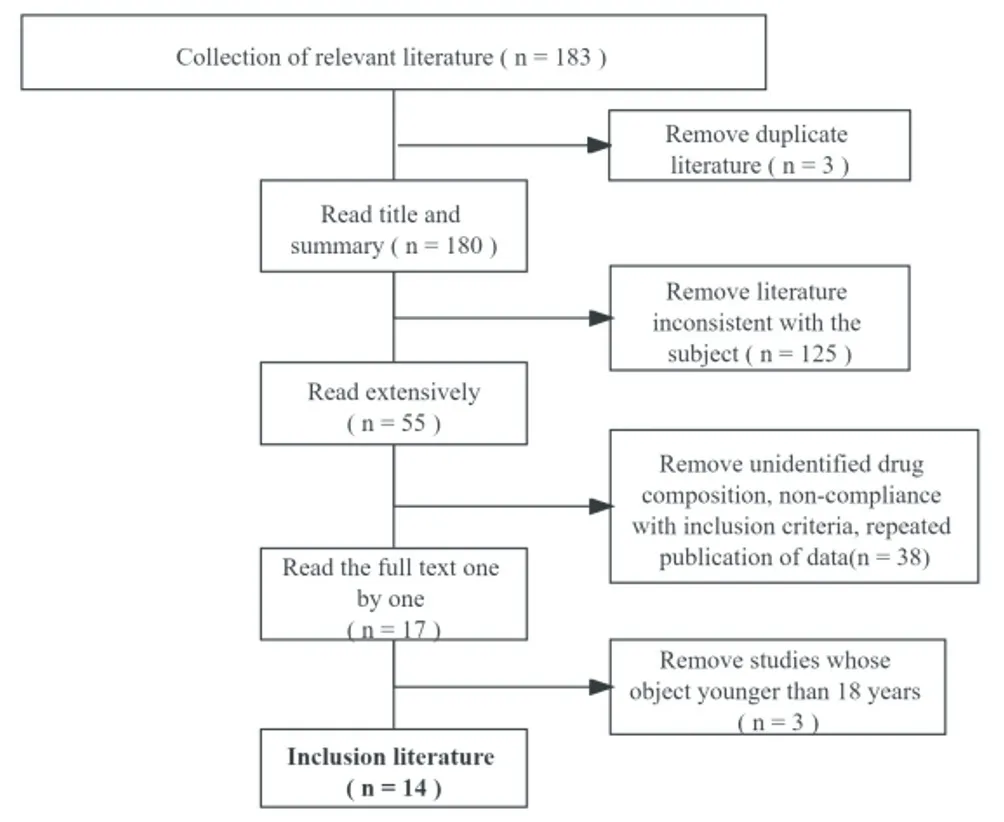
Figure 1 Flow chart of inclusion literatures
3.2 Characteristics of included literature
Fourteen literatures were published from 2010 to 2021. There were 836 patients with IMN, including 436 in the experimental group and 400 in the control group. The baseline data of the two groups were mentioned in each literature(gender, age, course of disease,condition before treatment, etc.) are balanced and comparable. The research objects of 4 literatures are syndrome differentiation of qi deficiency, blood stasis and damp heat, and the research objects of the other 10 literatures include: deficiency of spleen and kidney,deficiency of spleen and kidney, accumulation of damp heat, Qi deficiency and dampness resistance, damp heat and blood stasis,Qi deficiency and dampness stasis, spleen deficiency and damp heat, deficiency of spleen and kidney yang, and unknown syndrome differentiation. The experimental groups of 4 literatures were treated with Yiqi Huoxue Qingli traditional Chinese medicine on the basis of the control group;The control group of 13 literatures used basic Western medicine treatment (low salt, low fat, high-quality and low protein diet, hypotension, anticoagulation, diuresis, lipid regulation, etc.); the control group of 11 literatures used hormones or immunosuppressants. The main characteristics of included trials were demonstrated in Table 1.
3.3 Risk of bias of included trials
Seven of 14 articles used appropriate randomization methods and were at low risk of bias; The remaining 7 articles did not recount specific randomization methods. One literature implemented blinding, which is of low risk of bias, and the remaining 13 did not describe whether or not blinding was implemented. None of the 14 literatures recounted the allocation concealment. 5 articles had incomplete reporting of outcome data and were at high risk of bias;The remaining 9 had complete outcome data and were at low risk of bias; Selective outcome reporting was present in 2 literatures, which were at high risk of bias, and the remaining 12 literatures were at low risk of bias. The subjects of 5 articles did not use hormone and immunosuppressant therapy for nearly 1 month, which was low risk of bias.In short, the included trials were evaluated for low methodological quality using a risk of bias assessment tool(Table 2 and Fig.2).
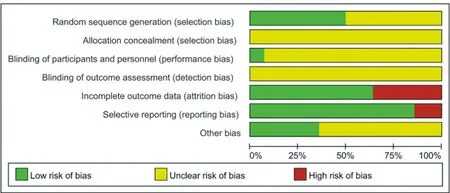
Figure 2 Risk of bias assessment
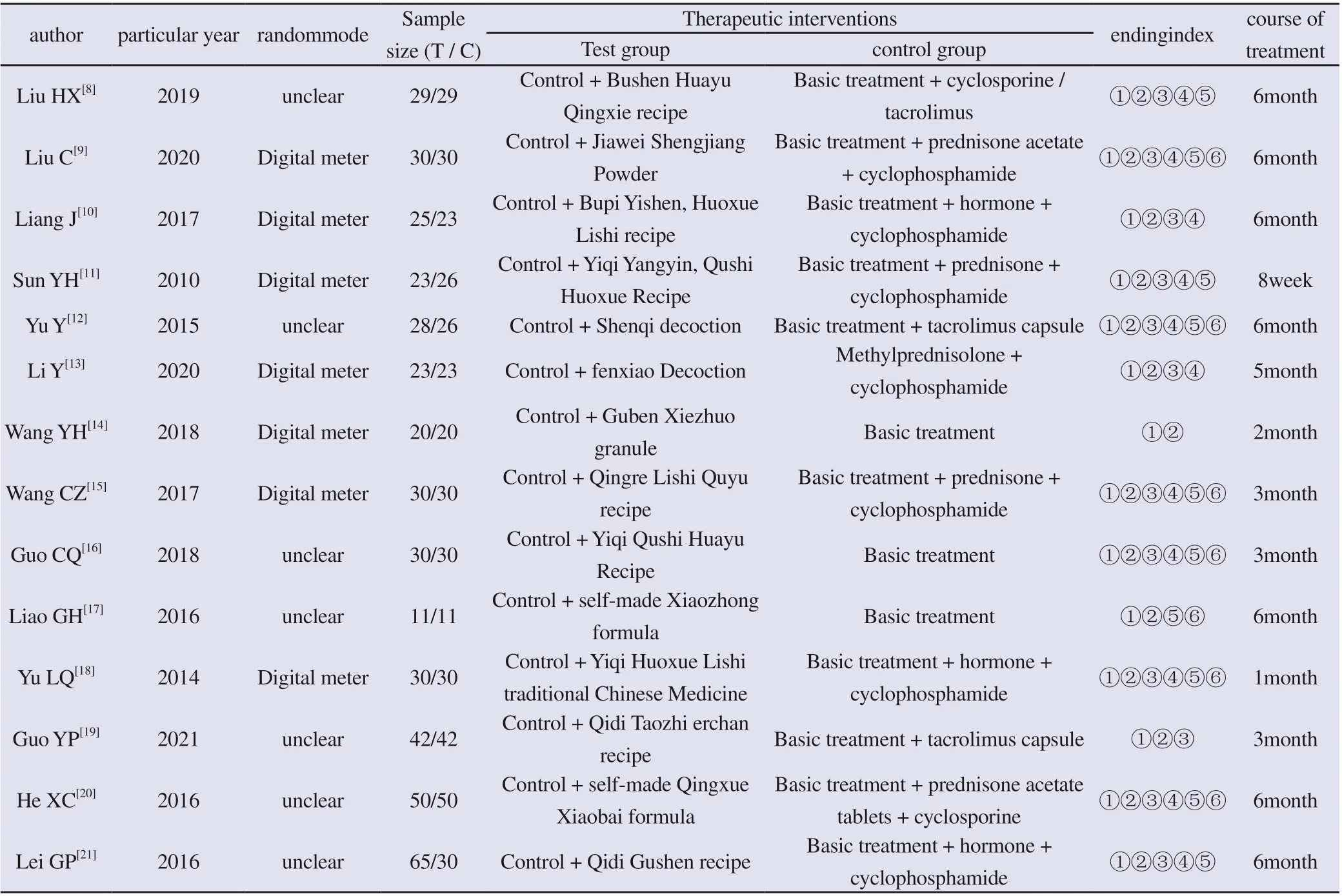
Table 1 Basic content of the included literatures

Table 2 Quality evaluation of included studies
3.4 Efficacy evaluation
24-hour urine total protein quantity(24 hUTP)Fourteen studies compared the effect of lowering 24hUTP in test versus control groups[8-21]. The overall pooled heterogeneity was I2=92%. Statistical results: WMD = -0.97, 95% CI (-1.30, - 0.65),Z= 5.86 (P < 0.00001), the efficacy of the test group in reducing 24hUTP was significantly better than that of the control group,with statistically significant differences. According to the syndrome differentiation classification of study subjects in the literature, the included literatures were divided into two subgroups of syndrome of qi deficiency, blood stasis, dampness and heat and syndrome of non Qi deficiency, blood stasis, dampness and heat.The results showed that, the experimental group reduced the 24hUTP of patients with syndrome of qi deficiency blood stasis dampness better than the control group, with a statistically significant difference [WMD =-0.95, 95% CI (-1.37, - 0.54), z = 4.50, P < 0.00001]. The effect of the experimental group in reducing 24hUTP in patients with non Qi deficiency, blood stasis, dampness and heat syndrome was better than control groups’, with a statistically significant difference [WMD= -0.97, 95% CI (-1.35, - 0.60), z = 5.06, P < 0.00001](Fig.3).Fig. 3 Forest Map of 24-hour urine protein
3.5 Albumin(ALB)
Fourteen studies compared the effect of raising ALB in the experimental and control groups [8-21]. The overall pooled heterogeneity was I2=90%, suggesting substantial heterogeneity among the data. The results of the analysis showed that WMD =3.83, 95% CI (2.10, 5.57), z = 4.33, P < 0.0001, the effect of the test group to elevate ALB was significantly better than that of the control group, which was statistically significant. According to the syndrome differentiation classification of the studied subjects in the literature, we divided the literature into two subgroups, syndrome of qi deficiency, blood stasis, dampness and heat and non Qi deficiency blood stasis dampness heat syndrome. The results showed that the test group elevated the ALB of IMN patients with Qi deficiency blood stasis dampness syndrome better than the control group, with a statistically significant difference [WMD = 3.16, 95% CI (1.80,4.51), z = 4.57, P < 0.00001]. The effect of the experimental group to elevate ALB in IMN patients with non Qi deficiency and blood stasis and dampness heat syndrome was superior to that of the control group with statistical significance [WMD = 4.10, 95% CI (1.83,6.38), z = 3.53, P = 0.0004](Fig.4).
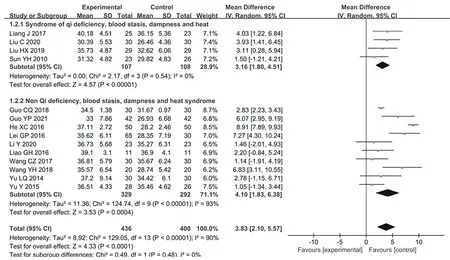
Figure 4 Forest Map of serum albumin
3.6 Total cholesterol(TC)
Twelve studies compared the effect of experimental and control groups on TC levels [8-13, 15, 16, 18-21]. The overall pooled heterogeneity I2= 74%, which suggested high inter data heterogeneity, so we used a random effects model to analyze.The statistical results showed that WMD = -0.82, 95% CI (-1.08, -0.56), Z= 6.18, P < 0.00001, the effect of reducing TC level in the experimental group was significantly better than that in the control group, and the difference was statistically significant(Fig.5).
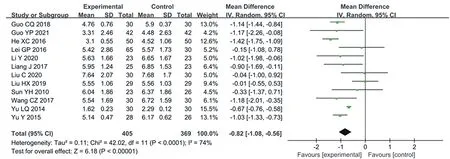
Figure 5 Forest Map of serum total cholesterol
3.7 Triglyceride(TG)
Eleven studies compared the effect of test and control groups on TG levels [8-13, 15, 16, 18, 20, 21]. The overall pooled heterogeneity I2= 96%, suggesting significant heterogeneity between the data, was analysed using a random effects model. Statistical results: WMD= -0.39, 95% CI (-0.67, - 0.11), z = 2.77, P = 0.006), the effect of reducing TG levels in the test group was significantly better than that of the control group, with statistically significant differences(Fig. 6).Fig. 6 Forest Map of serum triglyceride
3.8 Serum creatinine(Scr)
Ten studies compared the effect of test and control groups on SCR levels [8, 9, 11, 12, 15-18, 20, 21]. Overall post hoc heterogeneity I2= 98%, suggesting significant heterogeneity between data, was analysed using a random effects model. The statistical results showed the following: WMD = -5.52, 95% CI (-18.06, 7.03), z = 0.86, P =0.39, which indicated that the effect of the test group on SCR was not significantly different from that of the control group(Fig. 7).

Figure 7 Forest Map of serum creatinine
3.9 Blood urea nitrogen(BUN)
Seven studies compared the effects of test and control groups on BUN levels [9,12,15-18,20]. The overall pooled heterogeneity I2 =97%, which suggested significant heterogeneity among the data,was analyzed using a random effects model. The statistical results showed that WMD = -0.90, 95% CI (-2.22, 0.41), z = 1.35, P = 0.18,which indicated that the effect of the test group to reduce bun was not statistically significant compared with the control group(Fig. 8).

Figure 8 Forest Map of serum urea nitrogen
3.10 Safety evaluation
Adverse effects occurred during the trial in six studies [8,10-13,15]. During the course of treatment, 25 adverse events occurred in the test group, including infection, gastrointestinal reaction,acne, leukopenia, insomnia, abnormal liver function and Kirschner body habitus. Adverse events were reported in 59 patients in the control group, including infections, gastrointestinal reactions, acne,leukopenia, insomnia, abnormal liver function tests, coxsackiella body habitus, elevated blood glucose, and acute renal failure. The heterogeneity results were as follows: I2= 0, which indicated little heterogeneity among the data, and the fixed effect model was used for analysis. (95% CI [0.16, 0.50], z = 4.35, P < 0.0001), indicating that the test group had significantly less adverse effects than the control group(Fig. 9).

Figure 9 Forest Map of adverse reaction
3.11 Statistical analysis
3.11.1 Analysis of heterogeneityThe results of the meta-analysis on the combination of the method of enriching qi, activating blood circulation, clearing away dampness and heat combined with western medicine in patients with IMN in reducing 24hUTP, TC, TG, SCR, BUN, and elevating ALB were all greater than 50%, suggesting a large heterogeneity. The clinical homogeneity across studies (the baseline is approximately comparable in terms of gender, age, disease duration, etc.), so the initial consideration of heterogeneity may stem from the large differences in TCM composition among the test groups. In addition, the subjects of each study differed according to syndrome differentiation, and the laboratory indexes were not clearly defined by the criteria of nanotoxoid in each study, which resulting in a large heterogeneity in the literature. Therefore, the above indexes were analyzed by random effects model.
3.11.2 Publication bias and sensitivity analysisA funnel plot was made for the 24hUTP of the method of enriching qi, activating blood circulation, clearing away dampness and heat combined with western medicine for IMN, publication bias analysis was performed. The results showed that the funnel plot was approximately symmetrical, so there was less possibility of publication bias(Fig.10). At last, we observed whether the analysis results changed by excluding the literature one by one to perform sensitivity analysis for each outcome measure in the meta-analysis.The results showed that each outcome measure was relatively stable,so the results of meta-analysis were basically reliable.

Figure 10 Funnel plot of 24-hour urine protein
4. Discussion
At present, it is considered that IMN is an organ-specific autoimmune podocyte disease. The immune complex in the circulation is deposited in the glomerular basement membrane,which can activate the complement system, increase the permeability of the basement membrane and form proteinuria, and a large number of proteinuria further aggravates glomerular damage[22].Immunosuppressive therapy can reduce proteinuria, but there are problems such as easy recurrence after drug withdrawal and increased risk of hospitalization, which have become the difficulties in the treatment[5].
In order to systematically evaluate the efficacy and safety of the TCM method of enriching qi, activating blood circulation,clearing away dampness and heat combined with western medicine in the treatment of IMN, this study included RCTs of the TCM method combined with western medicine in the treatment of IMN for statistical analysis. The results of meta-analysis showed that on the basis of basic treatment or hormone combined with immunosuppressive therapy, this TCM therapy could significantly reduce 24hUTP, TC and TG of IMN patients and increase ALB compared with western medicine alone. In this study, the main indexes of 24hUTP and ALB were analyzed by subgroup analysis.The results showed that the TCM method combined with western medicine in the treatment of IMN patients with Qi deficiency and blood stasis and dampness-heat syndrome and non-Qi deficiency and blood stasis and dampness-heat syndrome was superior to western medicine alone in reducing 24hUTP and increasing ALB, and the difference was statistically significant. In addition,the safety evaluation results of meta-analysis showed that the incidence of adverse reactions in the six study groups (the TCM method combined with hormones and immunosuppressants) was significantly lower than that in the control group (hormone combined with immunosuppressants), and the difference was statistically significant. Thus, this kind of TCM treatment can reduce the side effects of hormones and immunosuppressants. But in improving renal function, compared with the control group, the difference was not statistically significant. It may be related to the different renal function levels and short observation time of the subjects included in the literatures. For this result, high-quality clinical trials are needed to confirm.
4.1 Discussion on etiology and pathogenesis of IMN in traditional Chinese medicine
According to the symptoms of IMN edema and proteinuria,the disease is mostly attributed to ‘edema’ and ‘turbid urine’ in traditional Chinese medicine. IMN is prone to middle-aged and elderly people, whose physical characteristics is qi deficiency of spleen and kidney. Improper diet will damage the spleen and stomach, and mental overwork will damage the spirit of the kidney[23]. ‘Suwen · Acupuncture Theory’ emphasizes that ‘healthy qi exists, evil cannot be dried. ’ ‘Ling shu·The beginning of diseases’emphasizes that ‘Evil of wind, rain, cold and hot, cannot hurt people alone. ’ Both emphasize the protective effect of healthy qi.Studies have found that IMN is associated with long-term exposure to PM2.5[24]. PM2.5 often appears at the same time with haze weather. Traditional Chinese medicine believes that haze is a special exogenous evil. Because there is more water vapor in the fog, it has the nature of dampness, and haze contains a variety of toxic components, which can invade the lung from the mouth and nose,thereby damaging the human organs[25]. ‘Jinguiyaolue(Synopsis of Golden Chamber)’ said that ‘Every kinds of evils have their characteristics when invasion people... .When the human body ’ s lung defense is weak, it can lead to the occurrence of ‘integrity is not superior to evil’. Fog injury in the upper, fog with toxic and harmful substances through the mouth and nose into, obstructing the lung,block lung qi, can cause lung loss Xuansu, wet cohesion. Wet is Yin evil, heavy turbidity down, although from the mouth and nose lung, but easy to hurt the middle and lower Jiao, spleen and kidney,damage the Yang of spleen and kidney. 'Suwen · Inverse tone theory' carried ' kidney water, main body fluid. ‘ Qing·Tang Rongchuan said, ‘The spleen can make water, so the kidney qi is also sealed...Spleen without water is kidney water flooding... Kidney is a house of water and fire, when kidney qi is deficient, qi does not change water, or spleen qi deficiency, inability to transport, water is not controlled, can cause water metabolism disorders and edema. ‘Suwen· Five Viscera Distinction Thesis ' contains ' the so-called Five Viscera, storing essence without purging ', ' Suwen · Six Sections of Zangxiang Theory ' contains ' kidney, the main sting, the root of seal, essence. Protein as the human body ' s ' fine material ' running around the body, depends on the transportation of spleen and kidney sealing effect. Proteinuria can occur when kidney qi is deficient,lost to seal, spleen qi is deficient, and lost to solid absorption. On the other hand, fog is wet evil, its viscous nature, easy to generate hot and humid, just as Xu Lingtaiyun ' wet is hot, although not necessarily, but the wet evil is easy to heat ', when the hot and humid evil, can cause the disease repeatedly, hot and humid steam on the chest tightness, head weight like wrapped, hot and humid block the spleen and stomach can lead to anorexia epigastric fullness. Wet viscosity can easily inhibit qi movement, impede blood circulation,and qi deficiency cannot promote blood operation, which can cause renal collateral stasis. Therefore, the deficiency of lung, spleen and kidney qi is the pathogenesis basis of IMN, and the invasion of exogenous pathogens is the occurrence and development condition of IMN. Deficiency, dampness, heat and blood stasis are the key pathogenesis of IMN. The results of Meta-analysis showed that for IMN patients with syndrome differentiation of non-Qi deficiency,blood stasis and damp-heat syndrome, the method of invigorating qi and activating serum was superior to the control group in reducing 24 hUTP and increasing ALB. To some extent, it can be explained that IMN patients have the basic pathogenesis of Qi deficiency,dampness, heat and blood stasis.
4.2 Clinical applications and experimental studies of the TCM method in treating IMN
The treatment of IMN with the TCM method is reflected in the academic thoughts and prescriptions of many physicians. Professor Lv Renhe, a master of traditional Chinese medicine, believes that the pathogenesis of MN is based on kidney deficiency[26]. In the process of disease progression, pathological products such as qi stagnation, blood stasis and phlegm dampness accumulate in kidney collaterals, which can form “ kidney collaterals micro-abdomen ”for a long time. The clinical manifestations include edema, foam urine, anorexia, epigastric discomfort, stuffiness and stuffiness, and other damp-heat pathogens that block qi movement. It should be treated with clearing heat and removing dampness, supplementing qi and activating blood circulation to dredge collaterals. Professor CHEN Yiping believes that IMN has four pathogenesis : deficiency,dampness, blood stasis and heat. She points out that the mutual adhesion of dampness, heat and blood stasis can often lead to edema and aggravation of proteinuria, which makes the disease recurrent and difficult to heal. There are even ‘Guange’ perilous conditions[27], such as occlusion of the lower gate, accumulation of drowning toxin, and inversion of middle energizer qi. It is proposed that the deposition of glomerular basement membrane immune complex belongs to the accumulation of dampness-heat glue in traditional Chinese medicine, and the treatment of IMN is based on supplementing qi and activating blood circulation, and removing dampness and clearing heat[28]. Banzhilian(Scutellaria barbata)and Baihuasheshecao(Hedyotis diffusa) are used to clear heat and remove dampness, and Danggui(Angelica sinensis) and leech are added to promote blood circulation and remove blood stasis in clinical, so as to promote the dissipation of immune complex.Related animal experiments showed that the treatment can reduce the 24hUTP of membranous nephropathy classic model rats,accelerate the clearance of glomerular in situ immune complexes,alleviate the pathological damage of podocyte foot process fusion and glomerular basement membrane thickening in rats, and has a certain protective effect on podocytes. The mechanism may be related to up-regulating the mRNA expression of some podocyte functional proteins and down-regulating the expression of membrane protein[29-31]. Clinical research found that the patients with high titer of anti-phosphatase A2 receptor antibody in the serum of IMN patients had higher severity of the disease, and this treatment could continuously reduce the antibody level in the serum of IMN patients with qi deficiency and blood stasis and dampness-heat syndrome[32].Professor Ye Chuanhui attaches great importance to the influence of damp evil on glomerulonephritis. She believes that damp evil is tangled, viscous and turbid, and it is easy to generate damp heat for a long time, which can lead to recurrent renal proteinuria. After the nephritis enters the chronic phase, the pathological changes are mainly glomerular and renal tubular sclerosis, glomerular atrophy and interstitial fibrosis. Professor Ye Chuanhui believes that this is a phenomenon of blood stasis. Therefore, in the treatment of chronic nephritis proteinuria, on the basis of syndrome differentiation and treatment, Ye 's method of promoting blood circulation and removing blood stasis, medicinal Danshen(Salvia miltiorrhiza),Chuanxiong, Taoren, Honghua, etc.[33].In this study, the prescription used in the experimental group of the included literatures contained Huangqi(astragalus), modern pharmacological studies showed that astragalus has the effect of regulating immunity and inhibiting platelet aggregation, and its component astragaloside IV can alleviate podocyte injury in rats with Heymann nephritis, reduce 24hUTP and increase ALB[34]. TCM for promoting blood circulation and removing blood stasis, such as Chuanxiong, Danshen, Sanqi and Honghua, can improve the hypercoagulable state of IMN in varying degrees by antithrombotic, antiplatelet aggregation and lowering blood lipids, which can play a preventive anticoagulant role and improve the prognosis of patients[35].
The results of this study showed that the method of enriching qi, activating blood circulation, clearing away dampness and heat combined with western medicine in the treatment of IMN was superior to western medicine alone in reducing 24-hour urinary protein, increasing serum albumin, and reducing blood lipid levels, and could reduce the side effects of hormones and immunosuppressants. Its mechanism may be related to regulating immunity, correcting hypercoagulable state, reducing glomerular capillary lesions, accelerating in situ immune complex clearance and promoting the recovery of basement membrane charge barrier.Therefore, in the process of clinical diagnosis and treatment of IMN, we should pay attention to the application of this kind of TCM method. However, the effect of this method combined with western medicine on renal function in patients with IMN is similar to that of western medicine treatment group, which may be related to the small number of documents and cases included in this study, the different levels of renal function among the subjects and the short treatment time of some studies. At the same time, there are still limitations and shortcomings in this study. First, the quality of the included literature is low, such as the lack of description of the implementation of allocation concealment and blinding method, which makes the final therapeutic effect more likely than the actual situation.Second, the included studies had a short follow-up time and could not explain the long-term efficacy of this TCM combined with western medicine in the treatment of IMN.Third, the inclusion criteria in this study did not define the renal function indexes of the subjects, and it was impossible to explain the effect of this TCM method combined with western medicine on renal function of patients with IMN.Therefore, the evidence intensity of this research conclusion needs to be improved. In order to reach a more convincing conclusion, it is necessary to further carry out the well-designed multi-center, large sample and randomized double-blind controlled clinical trials.
Conflict of Interest Statement
All the authors read and understood the policy statement of Journal of Hainan Medical University. We have no competing interests.
Author’s contribution
Zhang Zhengmei was responsible for the collection of literature screening, data extraction and writing of the article, Wang Meijie participated in literature collection and data extraction, Shen Zilong participated in literature screening, Li Jing reviewed the intellectual content of the article and gave guidance.
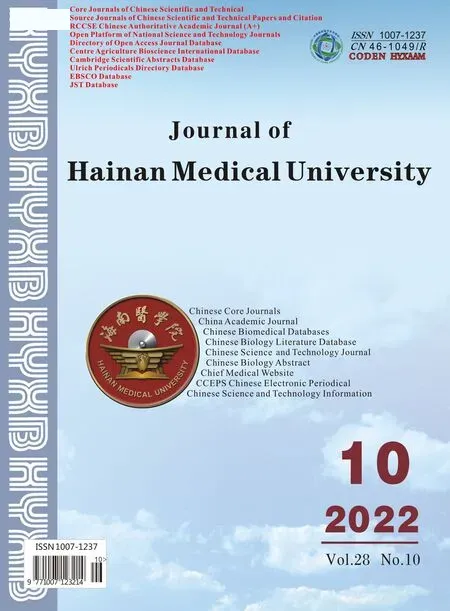 Journal of Hainan Medical College2022年10期
Journal of Hainan Medical College2022年10期
- Journal of Hainan Medical College的其它文章
- Study on the medication rules of traditional Chinese medicine in the treatment of sleep disorder after stroke based on data mining
- Intervention effect and mechanism of Jisheng Shenqi Decoction plus Panax notoginseng and Bionjia on CCl4-induced hepatic fibrosis rat model
- Effects of acupuncture combined with Kaijingtongmai Decoction on ATP sensitive potassium channel related proteins Kir6.1 and Kir6.2 in myocardial infarction rats
- Exploring the molecular biological mechanism of Shugan Jianpi Decoction in the treatment of depression-related breast cancer based on network pharmacology
- Effects of LPS-induced cholangitis on the cytoskeleton morphology of bile duct epithelium and the intervention mechanism of Dahuang Lingxian formula for these changes
- Effects of stress of different duration on depression-like behavior and expression of CB1 and GluA1 in medial prefrontal cortex of rats
